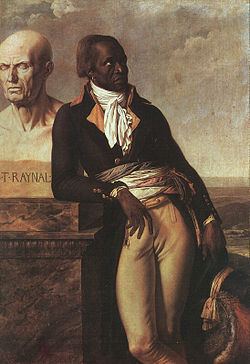Name Jean-Baptiste Belley | ||
 | ||
Jean-Baptiste Belley (c. 1746 – 1805) was a native of Senegal and former slave from Saint-Domingue in the French West Indies who during the period of the French Revolution became a member of the National Convention and the Council of Five Hundred of France. He was also known as Mars.
Contents

Life
Belley was said to have been born on 1 July 1746 or 1747 on the island of Gorée, Senegal, but the dates of his birth and death are uncertain. At the age of two, he was sold to slavers sailing for the French colony of Saint-Domingue. With his savings, he later bought his freedom.
In 1791, the enslaved Africans of Saint-Domingue began the Haitian Revolution, aimed at the overthrow of the colonial regime. As their fellow revolutionaries in France thought the Declaration of the Rights of Man of 1789, they began to see that slavery would need to be abolished.
In 1793, Belley was a Captain of infantry, fought against the colonists of Saint-Domingue and was six times wounded. On 24 September 1793, he was one of three members (deputés) elected to the French National Convention by the northern region of Saint-Domingue, together with Jean-Baptiste Mills, a mulatto, and Louis-Pierre Dufaÿ, a European, thus becoming the first black deputy to take a seat in the Convention. On 3 February 1794, he spoke in a debate in the Convention when it decided unanimously to abolish slavery.
However, the formal abolition of slavery did not disarm the European colonists' supporters, and although he was recognized as a full citizen of the Republic, Belley had to struggle against racist insinuations. He was an active spokesman for people of colour. When Benoît Gouly, a pro-slavery deputy from Mauritius in the Indian Ocean, called for special laws for the colonies, Belley denounced a pressure group of colonists meeting at the Hôtel Massiac in a speech published under the title Le Bout d'oreille des colons, ou le système de l’Hôtel Massiac mis à jour par Gouly. He succeeded for a time in maintaining the Republican principle of equality between people in France and in its colonies, whatever their colour.
In a declaration of age and marital status for the representatives of Saint-Domingue in the Convention, Belley says that he was born at Gorée, is forty-eight years old, has never left the territory of the Republic, and has lived forty six years at Cap-Français. In a 'declaration of fortune' dated at Paris on 10 Vendémiaire, Year 4 of the Republic (viz., 1 October 1795), Belley declares that from the Republic he has only his 'emoluments', that he has bought no property, and that he owns only the contents of his room.
Belley remained as a Convention member until 1797, when he lost his seat. He returned to Saint-Domingue with Charles Leclerc's expedition of 1802 as an officer of gendarmes, but he was arrested, sent back to France and imprisoned in the fortress of Belle Île. He was still being held prisoner there in 1805 when he wrote to Isaac Louverture, the son of Toussaint Louverture. He died later the same year.
Portrait
In about 1797, Belley's portrait was painted by Anne-Louis Girodet de Roussy-Trioson (1767–1824), a former pupil of Jacques-Louis David, and was exhibited in Paris in 1798. In this painting, Girodet evokes the tensions of the period. Belley, standing, wears the uniform of a Convention member, with a tropical landscape behind him, and has a stylish relaxed pose, as favoured in many French political portraits of Revolutionary politicians. His elbow rests on a bust of the philosopher Guillaume-Thomas Raynal (1713–1796), author of A Philosophical and Political History of the Settlements and Trade of the Europeans in the East and West Indies (1770). Raynal, who had just died, had been a supporter of the abolition of slavery.
Some modern critics have claimed that, in the age of European Neoclassicism (though Girodet was an early French Romantic painter), when depictions of the nude male form were modelled on and made explicit reference to the Classical (Ancient Greek and Roman) aesthetic ideal the prominence given in Girodet's portrait to displaying what is clearly a large penis in the sitter's breeches is a direct reinforcement and perpetuation of the Classical and since long-held notional correlation of savagery, animalistic tendencies and barbarity. Contemporary viewers of the portrait would have understood immediately the juxtaposition of elegant Western clothing on the body (and by corollary, the mind and spirit) of an individual from a race of people commonly viewed by native population of the time as uncivilised. The portrait therefore can more properly be seen also to reflect the then century-long held idea of the noble savage.
A drawing by Girodet for the portrait in ink and black chalk is in the Art Institute of Chicago, the restricted gift of the Joseph and Helen Regenstein Foundation, 1973. The portrait was used for the dust cover of Christopher Bayly's book The Birth of the Modern World 1780–1914: Global Connections and Comparisons (Oxford: Blackwell, 2004).
